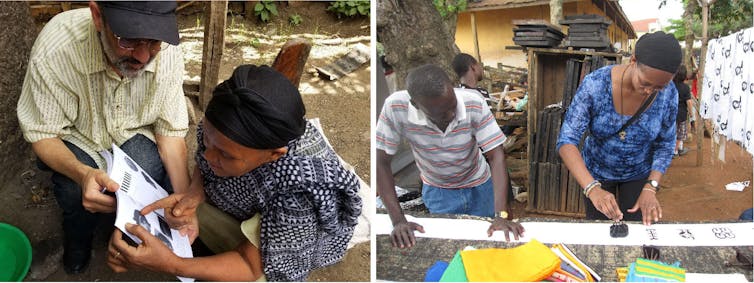

Audrey G. Bennett, University of Michigan and Ron Eglash, University of Michigan
The model of democracy in the 1920s is sometimes called “the melting pot” – the dissolution of different cultures into an American soup. An update for the 2020s might be “open source,” where cultural mixing, sharing and collaborating can build bridges between people rather than create divides.
Our research on heritage algorithms aims to build such a bridge. We develop digital tools to teach students about the complex mathematical sequences and patterns present in different cultures’ artistic, architectural and design practices.
By combining computational thinking and cultural creative practices, our work provides an entry point for students who are disproportionately left out of STEM careers, whether by race, class or gender. Even those who feel at home with equations and abstraction can benefit from narrowing the gap between the arts and sciences.
What are heritage algorithms?
Traditional STEM curricula often present science as a ladder you climb. For example, you might be told that math starts with counting, then goes to algebra, then calculus and so on.
But our research has found that the global history of science is more like a bush: Each culture has its own branching set of discoveries. Some of these discoveries offer a perspective that’s different from the theorem-proof approach for math or hypothesis-experiment approach for biology. Understanding the rules and techniques that create cultural patterns from the maker’s point of view can help bridge the gap between knowledge branches. We refer to these hybrids of computation and culture as heritage algorithms, and there are examples everywhere.

Flying over an African village, you can see the recursive geometry of African fractals in their architecture: circles of circles, rectangles within rectangles, and other “self-similar” structures. These fractal patterns also appear in their textiles, carvings, paintings, ironwork and more.
Other kinds of algorithms underlie the repeating sequences of bent wood arcs that make up Native American wigwams, canoes and cradles. Even henna tattoos demonstrate the interactions among computation, nature and culture.
These heritage algorithms challenge the myth of “primitive cultures” – the idea that early Africans had no math past counting on fingers or that Native American agriculture lacked sophistication.
The computational thinking that is embedded in Indigenous artifacts and other creative practices, such as weaving, beadwork and quilting, is not merely decorative. It also reflects different ways of thinking about the world. Our interviews with artisans revealed how they visualize spiritual concepts in formal techniques and numerical sequences.
Bringing heritage algorithms to the classroom
Heritage algorithms give students a way to blend the abstract rigors of math, the grounded legacies of culture and the infinite possibilities of art. To bring these algorithms to the classroom, we have created interactive computer programs and simulations that we call culturally situated design tools, or CSDTs.
Each CSDT was created in collaboration with Indigenous elders, street artists, traditional crafters and others. With the creators’ permission, we transfer their knowledge of pattern creation into digital tools that students enjoy using and teachers enjoy implementing in their lesson plans.

It’s important to craft each CSDT to reflect the way those artisans think about the cultural practice. For instance, the slope of the line y=x, mathematically calculated as “rise over run,” is 1 – for every unit you move up the line, you move a unit to the right. This line forms a 45-degree angle with the x-axis. But when Navajo weavers use this “up one, over one” pattern, the slope is closer to a 30-degree angle. This is because they weave yarn horizontally through vertical cords that are thicker than the yarn. So we made sure to preserve this feature in the weaving simulation we built.
A crucial aspect of CSDTs is that students may use them to follow their interests. This freedom and independence lets students encounter new cultures, delve deeper into their own identity or mix designs from different cultures to create something completely new.
We have seen Black students choose an Appalachian quilting simulation, Native American students choose cornrow simulations and white students create beadwork simulations. Students’ creative designs often mix many cultures together – cornrows become “powwow braids,” and African fractal simulations turn into plants, lungs and river deltas.

Heritage algorithms and CSDTs provide a powerful starting place for students to improve their computing skills and confidence. These tools even provide a foundation for a variety of careers, from architecture to environmental engineering.
When computation and culture collide
The reach of heritage algorithms has recently extended beyond learning environments to contemporary art spaces. Artists are generating a bold new creative style using “ethnocomputing” – an understanding of computer science from a cultural perspective.
You can see fresh interpretations of heritage algorithms in the African fractals embedded in the work of visual artist Tendai Mupita, the cornrow simulations integrated in the work of Rashaad Newsome, the blending of the African diaspora and technology by Nettrice Gaskins and the creative duo Tosin Oshinowo and Chrissy Amuah.
An exhibition on display in New York City, the U.K. and Los Angeles explores the textile techniques of artists inspired by the African American quilting tradition of Gee’s Bend, Alabama.

Our research on heritage algorithms is partially driven by a philosophical desire to reframe STEM as a source of radical joy for every ethnicity and identity. Inspired by the radical feminist phrase “sex-positive feminism,” we sometimes call our perspective “race-positive design” – thinking of race not in purely negative terms of oppression but instead as a rich source of creativity, liberation and a free-thinking mindset for curiosity and scientific inquiry.
This philosophical stance also has a practical side: statistically significant improvement in STEM scores for underrepresented students. Many teachers have recognized the potential of heritage algorithms for getting students invested in STEM. One teacher using the graffiti tool told us this was the first time students asked if they could stay in her math class after school. Another said she would never teach negative numbers again without the bead loom CSDT.
Heritage algorithms, both in the classroom and beyond, open up a two-way bridge between humanistic and technical knowledge. They offer a space where everyone – teacher and student, young and old, geek and artist – can learn, share and collaborate.
Audrey G. Bennett, University Diversity and Social Transformation Professor, Stamps School of Art & Design, University of Michigan and Ron Eglash, Professor of Information, University of Michigan
This article is republished from The Conversation under a Creative Commons license. Read the original article.



















